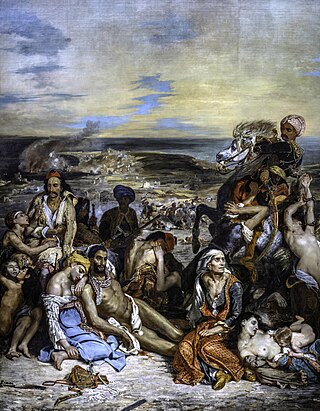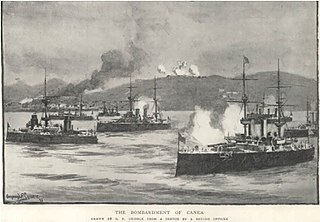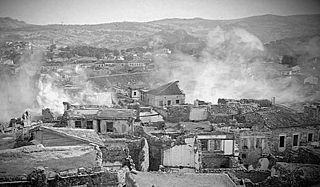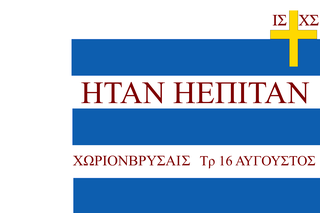
Crete is the largest and most populous of the Greek islands, the 88th largest island in the world and the fifth largest island in the Mediterranean Sea, after Sicily, Sardinia, Cyprus, and Corsica. Crete is located about 100 km (62 mi) south of the Peloponnese, and about 300 km (190 mi) southwest of Anatolia. Crete has an area of 8,450 km2 (3,260 sq mi) and a coastline of 1,046 km (650 mi). It bounds the southern border of the Aegean Sea, with the Sea of Crete to the north and the Libyan Sea to the south. Crete covers 260 km from west to east but is narrow from north to south, spanning three longitudes but only half a latitude.

The history of Crete goes back to the 7th millennium BC, preceding the ancient Minoan civilization by more than four millennia. The Minoan civilization was the first civilization in Europe.
The Cretan Gendarmerie was a gendarmerie force created under the Cretan State, after the island of Crete gained autonomy from Ottoman rule in the late 19th century. It later played a major role in the coup that toppled the government of King Constantine in 1916, and also in the World War II Battle of Crete and the Greek Resistance that followed.

Greek Muslims, also known as Grecophone Muslims, are Muslims of Greek ethnic origin whose adoption of Islam dates to the period of Ottoman rule in the southern Balkans. They consist primarily of descendants of Ottoman-era converts to Islam from Greek Macedonia, Crete, and northeastern Anatolia.

The Cretan Muslims or Cretan Turks were the Muslim inhabitants of the island of Crete. Their descendants settled principally in Turkey, the Dodecanese Islands under Italian administration, Syria, Lebanon, Palestine, Libya, and Egypt, as well as in the larger Turkish diaspora.

There were numerous massacres during the Greek War of Independence (1821–1829) perpetrated by both the Ottoman forces and the Greek revolutionaries. The war was characterized by a lack of respect for civilian life, and prisoners of war on both sides of the conflict. Massacres of Greeks took place especially in Ionia, Crete, Constantinople, Macedonia and the Aegean islands. Turkish, Albanian, Greeks, and Jewish populations, who were identified with the Ottomans inhabiting the Peloponnese, suffered massacres, particularly where Greek forces were dominant. Settled Greek communities in the Aegean Sea, Crete, Central and Southern Greece were wiped out, and settled Turkish, Albanian, Greeks, and smaller Jewish communities in the Peloponnese were destroyed.
The Pact of Halepa or Halepa Charter was an agreement made in 1878 between the Ottoman Empire and the representatives of the Cretan Revolutionary Committee, which secured wide-ranging autonomy for the island of Crete. It was named after the place where it was signed, Halepa.

Sir Alfred Biliotti was a Levantine Italian, born on Rhodes, who became a British consular official and amateur archaeologist. Biliotti probably received little formal education, and followed his father, who had carried out consular work for the governments of Britain, Spain and Tuscany, into the British consular service in 1849. He accompanied Charles Newton, an archaeologist then working for the British Foreign Service, on an archaeological tour in 1853, beginning a relationship of patronage by which Newton supported Biliotti in a twofold career, in the consulate and in archaeology.

The Cretan State was established in 1898, following the intervention by the Great Powers on the island of Crete. In 1897, the Cretan Revolt led the Ottoman Empire to declare war on Greece, which led the United Kingdom, France, Italy and Russia to intervene on the grounds that the Ottoman Empire could no longer maintain control. It was the prelude to the island's final annexation to the Kingdom of Greece, which occurred de facto in 1908 and de jure in 1913 after the First Balkan War.

The Cretan revolt of 1866–1869 or Great Cretan Revolution was a three-year uprising in Crete against Ottoman rule, the third and largest in a series of Cretan revolts between the end of the Greek War of Independence in 1830 and the establishment of the independent Cretan State in 1898.

The Theriso revolt was an insurrection that broke out in March 1905 against the government of Crete, then an autonomous state under Ottoman suzerainty. The revolt was led by the Cretan politician Eleftherios Venizelos, and is named after his mother's native village, Theriso, the focal point of the revolt.

The island of Crete was declared an Ottoman province (eyalet) in 1646, after the Ottomans managed to conquer the western part of the island as part of the Cretan War, but the Venetians maintained their hold on the capital Candia, until 1669, when Francesco Morosini surrendered the keys of the town. The offshore island fortresses of Souda, Grambousa, and Spinalonga would remain under Venetian rule until 1715, when they were also captured by the Ottomans.

The International Squadron was a naval squadron formed by a number of Great Powers in early 1897, just before the outbreak of the Greco-Turkish War of 1897, to intervene in a native Greek rebellion on Crete against rule by the Ottoman Empire. Warships from Austria-Hungary, France, the German Empire, Italy, the Russian Empire, and the United Kingdom made up the squadron, which operated in Cretan waters from February 1897 to December 1898.

The Yalova Peninsula massacres were a series of massacres during 1920–1921, the majority of which occurred during March – May 1921. They were committed by local Greek and Armenian bands with the invading Hellenic Army, against the Turkish Muslim population of the Yalova Peninsula. There were 27 villages burned and in Armutlu. According to journalist Arnold J. Toynbee c. 300 Muslims were killed during April–July 1921. In an Ottoman inquiry of 177 survivors in Constantinople, the number of victims reported was very low (35), which is in line with Toynbee's descriptions that villagers fled after one to two murders. Moreover, approximately 1,500 out of 7,000 Muslims remained in the region after the events or 6,000 had left Yalova where 16 villages had been burned. On the other hand, Ottoman and Turkish documents on massacres claim that at least 9,100 Muslim Turks were killed.

During the decline and dissolution of the Ottoman Empire, Muslim inhabitants living in Muslim-minority territories previously under Ottoman control often found themselves persecuted after borders were re-drawn. These populations were subject to genocide, expropriation, massacres, religious persecution, mass rape, and ethnic cleansing.

The massacre of Phocaea occurred in June 1914, as part of the ethnic cleansing policies of the Ottoman Empire that included exile, massacre and deportations. It was perpetrated by irregular Turkish bands against the predominantly ethnic Greek town of Phocaea, modern Foça, on the east coast of the Aegean Sea. The massacre was part of a wider anti-Greek campaign of genocide launched by the Young Turk Ottoman authorities, which included boycott, intimidation, forced deportations and mass killings; and was one of the worst attacks during the summer of 1914.

The Cretan revolt of 1878 was an insurrection of the Cretan people against the Ottoman occupation of the island. This insurrection is part of a larger movement for independence from the Ottoman Empire, which Crete was part of since the middle of the 17th century.

The Candia massacre occurred on 6 September 1898, on Crete, then part of the Ottoman Empire. It occurred as a reaction by armed Muslim irregular groups (Bashi-bazouks) to the offer to the Christian community of a series of civil rights by foreign powers. They attacked the British security force in Candia, which was part of an international security force on the island.
William Sydney Churchill (1860-1918) was a British Gendarmerie officer who served in Egypt, Crete, and Asia Minor during the Ottoman Empire.

The Cretan Revolt of 1897–1898 was a successful insurrection by the Greek Orthodox population of Crete against the rule of the Ottoman Empire after decades of rising tensions. The Greek insurrectionists received supplies and armed support first from the Kingdom of Greece; then later from the Great Powers: the United Kingdom, France, Italy, Austria-Hungary, Germany and Russia. The conflict ended in 1898 with Cretan-allied victory and Ottoman retreat when the Great Powers cut their funding and proposed a resolution which stipulated that the Island of Crete become an autonomous state under the nominal sovereignty of the Ottoman Empire, with the Prince George of Greece as governor, The Ottoman Empire recognize the sovereignty of the Kingdom of Greece and the Kingdom of Greece recognize the sovereignty of the Ottoman Empire.

















